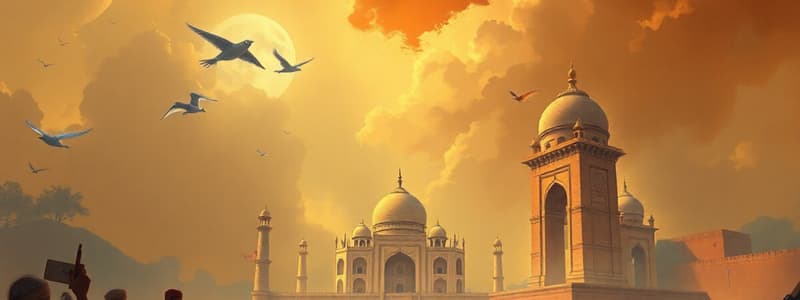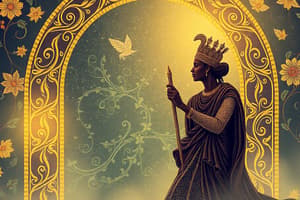Podcast
Questions and Answers
What significant change was introduced for the first time by the Indian Councils Act of 1909?
What significant change was introduced for the first time by the Indian Councils Act of 1909?
- Restoration of legislative powers to provinces
- Bicameralism in legislative structure
- Direct elections for Legislative Councils (correct)
- Indirect elections for Legislative Councils
Which of the following features was a part of the Government of India Act, 1919?
Which of the following features was a part of the Government of India Act, 1919?
- Complete autonomy for Indian provinces
- Establishment of the Public Service Commission (correct)
- Elimination of the Viceroy's control
- Constitution of the separate electorates for Hindus
What was a significant addition made to the Legislative Councils according to the Indian Council Act of 1892?
What was a significant addition made to the Legislative Councils according to the Indian Council Act of 1892?
- It enlarged the size and powers of the councils (correct)
- It removed indirect elections from the process
- It abolished the Legislative Councils in provinces
- It introduced communal representation
What change regarding seats for Muslims was introduced by the Morley Minto Reforms?
What change regarding seats for Muslims was introduced by the Morley Minto Reforms?
What did the term 'Dyarchy,' introduced in the Government of India Act, 1919, refer to?
What did the term 'Dyarchy,' introduced in the Government of India Act, 1919, refer to?
Which provinces had their legislative powers restored prior to the Indian Council Act of 1892?
Which provinces had their legislative powers restored prior to the Indian Council Act of 1892?
Which of the following was a key feature of the Government of India Act, 1919?
Which of the following was a key feature of the Government of India Act, 1919?
What was the purpose of the increase in size of the Legislative Council by the Indian Council Act of 1892?
What was the purpose of the increase in size of the Legislative Council by the Indian Council Act of 1892?
What is one major criticism of the Constituent Assembly of India?
What is one major criticism of the Constituent Assembly of India?
Which of the following is NOT a criticism leveled against the Constituent Assembly?
Which of the following is NOT a criticism leveled against the Constituent Assembly?
What role did Dr. B.R. Ambedkar play in the Constituent Assembly?
What role did Dr. B.R. Ambedkar play in the Constituent Assembly?
What does the secular provision in the Constitution signify?
What does the secular provision in the Constitution signify?
What was one of the primary reasons for forming the Constituent Assembly?
What was one of the primary reasons for forming the Constituent Assembly?
Why was the time taken by the Constituent Assembly to frame the Constitution considered reasonable?
Why was the time taken by the Constituent Assembly to frame the Constitution considered reasonable?
What was a significant characteristic of the Constituent Assembly members?
What was a significant characteristic of the Constituent Assembly members?
How did Dr. B.R. Ambedkar contribute to the understanding of India's needs during the drafting of the Constitution?
How did Dr. B.R. Ambedkar contribute to the understanding of India's needs during the drafting of the Constitution?
What does the social contract theory signify in the context of the Indian Constitution?
What does the social contract theory signify in the context of the Indian Constitution?
Which of the following principles is not emphasized by the Indian Constitution?
Which of the following principles is not emphasized by the Indian Constitution?
How does the Indian judiciary, particularly the Supreme Court, support the Constitution?
How does the Indian judiciary, particularly the Supreme Court, support the Constitution?
What role does the separation of powers play in the Indian Constitution?
What role does the separation of powers play in the Indian Constitution?
What embodies the collective will of the people in India?
What embodies the collective will of the people in India?
What does the Constitution’s commitment to social justice entail?
What does the Constitution’s commitment to social justice entail?
Which aspect of the Constitution promotes accountability?
Which aspect of the Constitution promotes accountability?
What is the significance of the Indian Constitution as a written document?
What is the significance of the Indian Constitution as a written document?
What was Bhimrao Ambedkar primarily known for?
What was Bhimrao Ambedkar primarily known for?
Which university did Ambedkar attend to earn his Ph.D.?
Which university did Ambedkar attend to earn his Ph.D.?
Which social issue did Ambedkar actively fight against?
Which social issue did Ambedkar actively fight against?
What honor was conferred upon Ambedkar in April 1990?
What honor was conferred upon Ambedkar in April 1990?
Which role did Ambedkar NOT hold?
Which role did Ambedkar NOT hold?
What movement did Ambedkar embrace on 14th October 1956?
What movement did Ambedkar embrace on 14th October 1956?
For which committee was Ambedkar selected by the British government?
For which committee was Ambedkar selected by the British government?
What was a major principle that guided Ambedkar's thoughts and actions?
What was a major principle that guided Ambedkar's thoughts and actions?
What was the main objective of Dr. B.R. Ambedkar?
What was the main objective of Dr. B.R. Ambedkar?
How did Dr. B.R. Ambedkar contribute to the Indian Constitution?
How did Dr. B.R. Ambedkar contribute to the Indian Constitution?
What continues to plague the conditions of untouchables and depressed classes in India?
What continues to plague the conditions of untouchables and depressed classes in India?
Which statement best represents Dr. B.R. Ambedkar's vision for society?
Which statement best represents Dr. B.R. Ambedkar's vision for society?
What challenge does the text suggest hinders the implementation of the Indian Constitution?
What challenge does the text suggest hinders the implementation of the Indian Constitution?
According to Ambedkar’s message to the people, what is essential for accomplishing their mission?
According to Ambedkar’s message to the people, what is essential for accomplishing their mission?
What did Dr. B.R. Ambedkar think about the role of political actors associated with his legacy?
What did Dr. B.R. Ambedkar think about the role of political actors associated with his legacy?
What methodology did Ambedkar use to challenge the caste system?
What methodology did Ambedkar use to challenge the caste system?
Flashcards are hidden until you start studying
Study Notes
Indian Constitution and Social Contract
- The Indian Constitution is a social contract, an agreement between the state and citizens outlining their rights and responsibilities.
- Citizens are guaranteed rights like freedom of speech, equality, and life.
- In return, citizens are expected to abide by laws and contribute to social and civic responsibilities outlined in the constitution.
The Indian Constitution as a Legal Framework
- The Constitution serves as the ultimate legal framework for all laws, resolving disputes, and interpreting legislation.
- The Supreme Court plays a crucial role in upholding the Constitution, ensuring compliance with its provisions and protecting individual rights.
- The Constitution establishes a political framework with a system of checks and balances among executive, legislative, and judicial branches.
Indian Council Acts (1861, 1892, 1909)
- The Indian Council Act of 1861 introduced Legislative Councils at the provincial and central levels.
- The Indian Council Act of 1892 expanded the Legislative Council's size and power, granting them the ability to deliberate on budgets and question the executive.
- The Indian Council Act of 1909 (Morley-Minto Reforms) introduced direct elections for Legislative Councils.
- The Act also established separate electorates for Muslims and appointed Indians to the Viceroy's Executive Council for the first time.
Government of India Act, 1919 (Montagu-Chelmsford Reforms)
- The Act instituted a bicameral system with separate provincial and central subjects.
- It introduced Dyarchy, a dual governance system for provincial subjects, dividing them into reserved and transferred subjects.
- It increased Indian representation in the Viceroy's Executive Council to three members.
- The Act established the Public Service Commission in India and extended communal representation to Christians, Anglo-Indians, and Sikhs.
Criticisms of the Constituent Assembly of India
- The Constituent Assembly was criticized for not being formed through universal suffrage and being dominated by Congress members and lawyer-politicians.
- Some argued it was not a sovereign body due to its formation during British rule.
- Critics also questioned the time taken to frame the Constitution.
- There were concerns about the dominant presence of Hindus within the Assembly.
Defending the Constituent Assembly
- The Assembly was comprised of members from all religions, castes, and cultures of the society, ensuring inclusivity and representation.
- The time taken to frame the Constituent Assembly was reasonable given the vastness of India and the need to represent all sections of society.
- The Constitution's secular provisions demonstrate its commitment to equal rights and opportunities for all, regardless of caste or religion.
- The Assembly played a crucial role in framing the Constitution, taking vital steps to ensure equal respect and rights for all.
DR. B.R. AMBEDKAR'S ROLE IN THE INDIAN CONSTITUTION
- Dr. Ambedkar was a prominent scholar, economist, political scientist, philosopher, and humanitarian who advocated for a democratic system in India.
- He argued for a democratic system as a solution to India’s socio-economic and political challenges.
- As the chairman of the Drafting Committee, Dr. Ambedkar played a significant role in creating the Indian Constitution.
- Dr. Ambedkar championed human rights and dedicated his life to the cause of Dalits, untouchables, and marginalized sections of society.
- He fought against social discrimination, upheld the rights of the Dalits, and advocating for inclusive democracy.
Dr. Ambedkar's Objectives
- Dr. Ambedkar aimed to eradicate the caste system and guide India towards a more civilized state.
- His relentless efforts and strategic approach shaped the Indian Constitution, providing opportunities for Dalits and women to exercise their freedoms and realize individual identity.
- His vision emphasized the need for implementing the Constitution in its true spirit to overcome social and economic evils in the nation.
- Dr. Ambedkar's goal to end caste discrimination and to build a society where human dignity, equal opportunity, and social justice are paramount is yet to be fully realized.
Studying That Suits You
Use AI to generate personalized quizzes and flashcards to suit your learning preferences.




